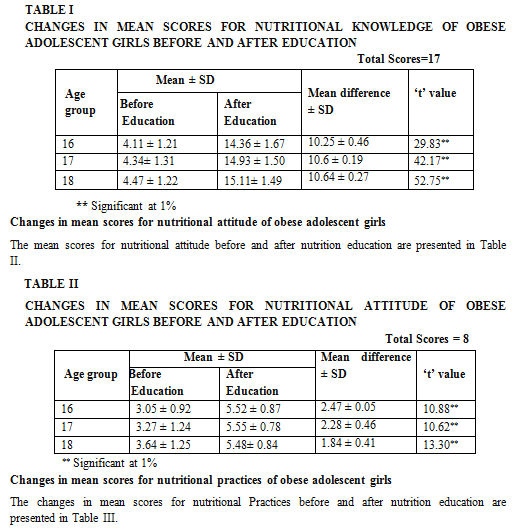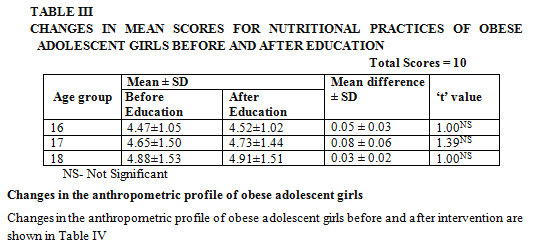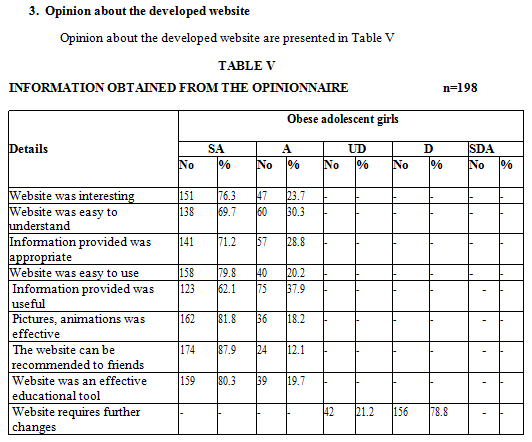IJCRR - 9(3), February, 2017
Pages: 34-38
Date of Publication: 10-Feb-2017
Print Article
Download XML Download PDF
Development of an Interactive Website on Metabolic Syndrome and its impact on obese Adolescent Girls
Author: Kalpana C. A.
Category: Healthcare
Abstract:Aim: Metabolic Syndrome has become one of the most severe health problems of the 21st century. In India, the overall prevalence of metabolic syndrome among adolescents is 4.2 per cent. World Wide Web has become indispensable and the most effective distribution channel in this era of digital technology and is convenient to use and capable of reaching adolescents. With this in view, the present study aimed to develop an interactive website on metabolic syndrome, impart nutrition education with the developed website and evaluate its impact on the nutritional knowledge of obese adolescent girls (16-18 years).
Methodology: An informative, responsive website was developed with the domain name metabolicsyndrome-km.com. The website included information on metabolic syndrome, causes, symptoms, risk factors, criteria to diagnose metabolic syndrome, diet plan for adolescents with metabolic syndrome, basic food groups, recommended daily allowances, indicator of metabolic syndrome and body mass index calculations.
Result: The website was developed using Hypertext Markup Language (HTML), Cascading Style Sheets (CSS) and Adobe Photoshop. The calculations and the questionnaire were computed using PHP: Hypertext Preprocessor and JavaScript. The software applications used to create HTML for the nutrition website was Dreamweaver.
Discussion: Obese adolescent girls (198) were educated and instructed to visit the developed metabolic syndrome website and changes in their nutritional knowledge and was evaluated. The nutritional knowledge attained through the website was evaluated by using a control panel with username and password url in which the viewers posted their questionnaire. A significant increase in nutritional knowledge after imparting nutrition education among obese adolescent girls was observed (p< 0.01).
Conclusion: The findings from this study provide a primary intervention strategy to increase awareness and promote healthy lifestyle among adolescents through advanced methods of nutrition education.
Keywords: Obesity, Metabolic syndrome, Adolescent girls, Nutritional knowledge, Website
Full Text:
Introduction
Adolescence is a prime time for health promotion and for establishment of healthy behavior that influence health in later years. They are at high risk for nutritional morbidity 1. Nutritional problems among adolescents are under nutrition, anemia, overweight or obesity, polycystic ovarian syndrome, eating disorder and metabolic syndrome it is common among adolescents throughout the world it not only affect their growth and development but also in future would their livelihood as adults2.India alone has 105 million adolescent girls and among them an overall prevalence of metabolic syndrome is 4.2 in 16-18 years age group3. Diet of today’s preadolescents and adolescents are low in fruits, vegetables, dairy products, whole grains, and high in total fats, saturated fats and added sugars 4. Changes in dietary habits are important in the treatment of metabolic syndrome. Nutrition health education is an effective method to improve the dietary behavior and provides great opportunity to learn about the essentials of nutrition for health and to take steps to improve the quality of their diets, thus their well5. Ninety three per cent of adolescents in the age groups of 16-18 years go online for nutrition information and the internet has become indispensable for various instrumental purposes6. With this in view, the objectives for the study were to develop an interactive website on metabolic syndrome, impart nutrition education using the developed Website and evaluate the impact of nutrition education on Obese adolescent girls.
Methodology
- Assessment of Nutritional Knowledge, Attitude and Practices (KAP) of selected
obese adolescent girls.
A specially designed pre-tested questionnaire which comprised of 35 multiple choice questions was formulated to assess the nutritional knowledge, attitude and practices of selected obese adolescent girls.
- Framing the content for the website
The topics considered for the content which aimed to inculcate nutritional knowledge on metabolic syndrome among the adolescents were Causes and symptoms of metabolic syndrome, Risk factors of metabolic syndrome, Treating and preventing of metabolic syndrome, Healthy food guide, Recommended Dietary Allowance, Basic Food groups, Dietary plan for metabolic syndrome and Body Mass Index Indicator for metabolic syndrome. A common logo was selected for all web pages in the website. The logo selected was “Small steps…..right Direction”
- Website Development Process: The website was developed with the expertise and help of a web programmer and designer as follows
Site Architecture: The web architecture for navigation and select screens was determined by the web programmer; the screens and interactive tools were created by the web designer.
Content-only Site Framework: A navigation map which outlines the structure of the entire web project, showing all pages within the site and the connections from one page to others was outlined.
- Website Production
Templates: Templates were created for typical pages at all levels for the website. Templates are skeleton files used to make finished pages by inserting texts, graphics, and other contents at marked places in templates 7.
Client-side Programming: The Scripts included in the nutrition website were style sheets and Java for the client- side programming. Client-side programs can make Web pages more interactive and responsive8.
Server-side Programming: Jquery and JavaScript programs were used for form processing in Questionnaire of the metabolic syndrome website The Web would be much less useful without the ability to request and process user input data 9.
Typography: Typography is a very important element of Web design. The fonts used in the nutrition website were Arial. The font size used was 14.
Images: Visual impact of shape, colour and contrast, web pages can be interesting graphically and will motivate the visitor to investigate their contents. Using images can enhance almost any web pages if used appropriately10.
Page Layout: Page layout is the part of graphic design that deals with the arrangement and style treatment of content on a page.
Colour: Green colour was used in the main background, white colour was used as a background for the contents and black colour was used with fonts in the contents.
- Reviewing and Testing Website
The Website was checked for any spelling mistakes and/or grammatical errors. The page layout was checked for its consistency. The programming written was tested for correct values. After viewing the entire website before it was published, it was rated for its acceptance and satisfaction with the interface and navigation, tone, colour and content of the website and the spelling mistakes were corrected.
6. Publishing the Website: Publishing a website is the process of making it available to the users. It involves actual uploading of the website to a server.
Domain Name: Websites are accessed by an IP address or a domain name. A domain name should be easy to pronounce, spell and remember. It should also relate to the website content. The domain name that was registered for the metabolic syndrome website was metabolicsyndrome-km.com.
7. Uploading the Website: File Transfer Protocol (FTP) program was used to upload files containing each individual web page to the server.
8. Programs and Tools Used
HTML: HTML stands for Hypertext Markup Language. The software application used to create HTML for the metabolic syndrome website was Dreamweaver.
Responsive Website: It is a responsive website and can be viewed easily in any device like computer monitors, tablets, mobiles, etc.
PHP: PHP stands for PHP: Hypertext Preprocessor. Mathematical calculations for Body Mass Index and Metabolic syndrome Calculations in the metabolic syndrome website were done using core PHP.
JavaScipt: JavaScript is a programming language that enhances HTML with animation, interactivity and dynamic visual effects. JavaScript programs were used to the correctness of the data input in the Questionnaire and Metabolic syndrome indicator calculation and calculate Your BMI forms on the client side.
Cascading Style Sheets: The Cascading Style Sheets (CSS) provides the designer the power to control design of the website11. From precise margins to pixel-perfect spacing to fonts and typefaces, CSS was used for the layout method in the metabolic syndrome
Photoshop: Photoshop was used to make the background of the images transparent to merge in the webpage of the metabolic syndrome website. The website can be accessed at metabolicsyndrome-km.com.
9. Implementation of Nutrition Education through the Developed Website
Nutrition education using the developed website on metabolic syndrome was imparted by the following methods.
1. The selected obese adolescent girls were instructed to assemble in a specific classroom fitted with an LCD projector and the investigator made the adolescent girls to view the website with the help of a laptop having internet facility.
2. Since the adolescent girls were students, they were able to view the website in the computer laboratory available in their own campus with due permission from their faculty.
3. The adolescent girls also viewed the website at their homes or in browsing centers and from their own laptops.
10. Evaluation of the Impact of Nutrition Education
Nutrition education was imparted to the obese adolescent girls and they were instructed to answer the questions posted in the questionnaire in the website and was evaluated by using control panel which is sent to the investigators email id by the website developers with username and password http://metabolicsyndromekm.com/admin-cp/. The post test questionnaire was also given in printed form. The post test was carried after duration of three months of nutrition education programme. The difference in scores of nutritional knowledge, attitude and practices was computed and analysed for any impact. Apart from this, the opinion of the selected obese adolescent girls on the developed website was assessed by administrating a designed opinionnaire.
The research design and the protocols used in the study were submitted for scrutinisation and approval to the Institutional Ethical Committee and Ethical Clearance and an approval certificate No : AUW/IHEC-14-15/FHP/FSN-01 was obtained from Avinashilingam University for Women, Coimbatore, Tamilnadu, India
Result
Changes in mean scores for nutritional knowledge of obese adolescent girls
The mean scores for nutritional knowledge of obese adolescent girls before and after education are presented in Table I




Discussion
The scores for nutritional knowledge before education were 4.1 and it had increased to 14.4 after education among the obese adolescent girls in the age group of 16 years, while among the obese adolescent girls in the age group of 17 years, the nutritional knowledge scores before education was 4.3 and it had increased to 15.0 after education and among the obese adolescent girls in the age group of 18 years, the nutritional knowledge scores before education were 4.5 and it had increased to 15.1 after education. Statistical analysis revealed a significant difference (p<0.01) between the initial and final values indicating that nutrition education given for a period of three months improved the nutritional knowledge of adolescent girls.
Nutrition education had changed the nutritional knowledge of the selected obese adolescent girls, but with regard to attitude and practice no changes were observed. The findings indicated that a longer period of intervention is necessary to bring modifications in the attitude and practices of adolescent girls which will have a long lasting impact on their behavior towards healthy life.
The mean weight of obese adolescent girls was 70.2, 71.7 and 72.2kg before intervention and had reduced to 70.1, 71.2 and 72.0kg with a negligible difference of 0.1 to 0.5 after intervention. BMI of obese adolescent girls was found to be 29.3, 29.9 and 30.1 before intervention respectively and the mean values reduced to 29.2, 29.7 and 28.1 after intervention. The reduction in BMI ranged from 0.1 to 0.3 which was statistically significant (p<0.05) in 18years obese adolescent girls. The mean waist circumference of obese adolescent girls ranged from 91.4 to 92.3cm before intervention and had reduced to 90.9 to 91.9 cm with difference of 0.4 to 0.5 after intervention. The mean body fat percentage of obese adolescent girls was found to be 36.1, 36.7 and 37.8 respectively which reduced to 36.0, 36.5 and 37.6 respectively.
Seventy six per cent of obese adolescent girls strongly agreed that the website was interesting. Eighty per cent of students strongly agreed that the website was an effective educational tool and the remaining 20 per cent students agreed on this. 79 per cent of the students disagreed that the website required further changes.
Conclusion
Prevalence of metabolic syndrome among adolescent girls shows an alarming increase. Severe obesity, age, pubertal status, presence of family history of cardiovascular disease, type 2 diabetes, obesity and hypertension appear to be important risk factors associated with metabolic syndrome in adolescence. Nutrition education through the developed website had changed the nutritional knowledge of the selected obese adolescent girls, but with regard to attitude and practice no changes were observed. The findings from this study provide an internet based primary intervention strategy to increase awareness and promote healthy lifestyles in schools and colleges thus preventing the problem of metabolic syndrome from becoming more widespread.
Acknowledgement
Authors acknowledge the immense help received from the scholars whose articles are cited and included in references of this manuscript. The authors are also grateful to authors/editors/publishers of all those articles, journals and books from where the literature for this article has been reviewed and discussed.
Source of Funding
Science and Engineering Research Board, Department of Science and Technology, Government of India.
References:
- Gouri Kumari Padhy, Anasuya Pattanayak, Dhaneswari Jena (2013), Effectiveness of Planned Teaching Programme on Reproductive Health Among Adolescent Girls. Indian Medical Gazette, Pg. 287.
- Gupta, N., and Kochar, G.K. (2009), Pervasiveness of anemia in adolescent girls of low socio-economic group of the district of Kurukshetra (Haryana). The Internet Journal of Nutrition and Wellness, Vol 7(1):pp.12.
- Narinder Singh, Ravi Kumar Parihar, Ghanshyam Saini, Sandeep Kumar Mohan, Neeraj Sharma, Mohd Razaq (2013) Prevalence of metabolic syndrome in adolescents aged 10-18 years in Jammu, J and K .Journal of clinical endocrinology and metabolism.
- Krebs P, Prochaska JO, Rossi JS. (2010), A meta-analysis of computer-tailored interventions for health behavior change. Prev Med, 51, pp.214–221.
- Qiaoling, Aiuna, LuFeng (2009), To Observe Effect of Nutrition Education in Non-Medical Speciality students. Modern Preventive Medicine, Vol.36 (8), pp.3492-4.
- Amanda, L., Kristen, P., Aaron, S., Kathryn, Z. (2010), Teens and Internet Use, Annual Review of Public Health, Vol.30, pp. 273- 292.
- Mathew, M. (2011), Creating a Website: The Missing Manual. O’ Reilly Media, Inc., US. Pg.151.
- David Flanagan (2008), Javascript: The definitive guide. 5th edition. O’Reilly media, Inc., US. Pg.237.
- Lopuck, L., (2011), Web design for dummies. 2nd edition. Wiley publishing, Inc.Pg.265.
- Shelly, G.B., Joy L. Starks (2010), Adobe photoshop Cs5: Introductory. Nelson education Ltd., Pg.2.
- West, R., Tom Muck, Tom Allen (2009), Dreamweaver Ultra Dev. 4: The Complete Reference. Tata Mc Graw-Hill Publishing Company Ltd. Pg.190.
|






 This work is licensed under a Creative Commons Attribution-NonCommercial 4.0 International License
This work is licensed under a Creative Commons Attribution-NonCommercial 4.0 International License